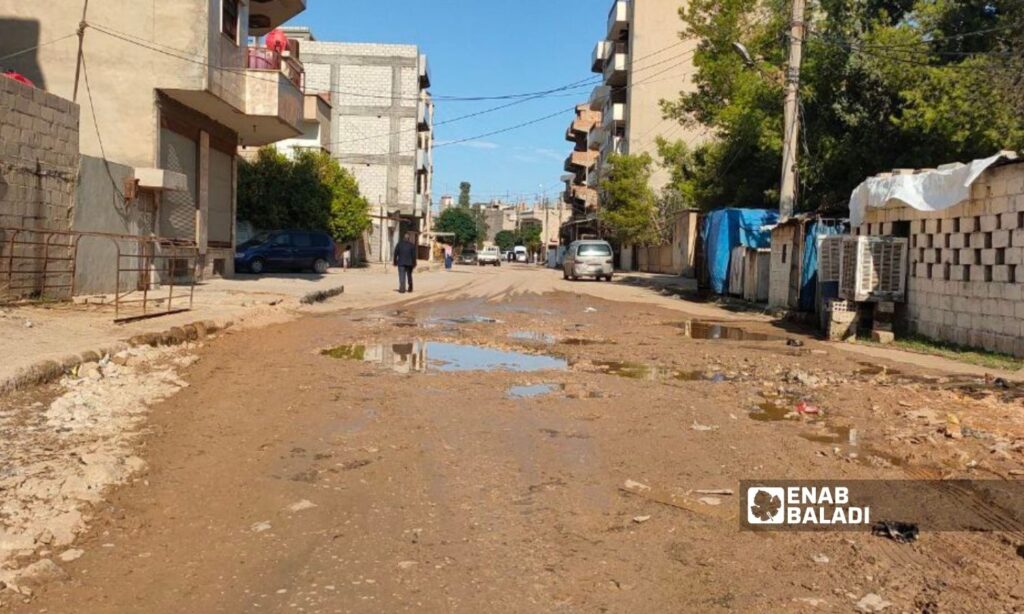Qamishli – Majd al-Salem
With each winter, as potholes and mud swamps spread along the streets of the city of Qamishli, Qamishli residents and motorists suffer more from the poor quality of public roads.
Despite repeated promises and budget allocations by the dominant The Autonomous Administration of North and East Syria (AANES), no actual achievement has taken place in addressing the problem.
In the Assyrian neighborhood, the people suffer from the large number of potholes that spread in the main neighborhood street, and this suffering increases with the advent of winter every year, as the street turns into swamps, and the passers-by get their share of mud flying, according to what Fawaz Husseinawi, 49, of the neighborhood, told Enab Baladi.
He added that every time the people file a complaint with the mayor of the neighborhood, demanding that the road be paved and maintained, the result is “promises without implementation.”
Husseinawi’s suffering has been going on for three years without a solution, although the people took a voluntary initiative to pave the road with gravel, but it disappeared with the large number of vehicles crossing the road.
The movement of many oil and fuel tanks daily, with a minimum load of 20 tons each, causes damage and cracking of highways, and this is concentrated in the summer, as temperatures reduce the hardness of the asphalt material and cause bends and grooves within the roads, according to Husseinawi.
Not only do the residents of the Assyrian neighborhood suffer from the difficulty of walking on the street, but also to secure their return to it via transportation, as taxi drivers ask for an increase of about 1,500 SYP above the customary fee as soon as they know that the passenger’s destination is al-Rayyan neighborhood.
Some taxi drivers refuse to enter the neighborhood by car, content with taking the customer to the outskirts, and the regular taxi fare from the market to the neighborhood reaches 4,000 SYP.
Al-Thawra neighborhood and AANES’ tunnels
In addition to the poor quality of its streets and the lack of pavement in most of them, the residents of al-Thawra neighborhood in Qamishli have been suffering since the beginning of last summer from the failure to remove the remnants of the tunnels dug by the AANES as dust, rocks, and cement beams spread in the neighborhood’s streets.
The 40-year-old Basel, who asked not to reveal his full name for security reasons, told Enab Baladi that his neighborhood had become “semi-isolated” due to the large number of remnants of the tunnels surrounding it, and with the recent rains, its streets became a “mud swamp and scattered water pools filled with mud.”
As soon as the neighborhood’s suffering from summer dust ends, the suffering of “the curse of mud” begins in the winter, according to Basel.
Residents of the neighborhood are afraid to file a complaint with the municipality about the deteriorating condition of the neighborhood’s streets as a result of digging tunnels, for fear of security persecution by the Syrian Democratic Forces (SDF), according to Basel.
He pointed out that a number of residents had to sell their homes at low prices to move to another neighborhood as a result of the deteriorating service situation.
According to what Enab Baladi monitored, other neighborhoods of the city remained without maintenance, especially the eastern neighborhoods such as “Suez Canal,” “Gamaya” and “Alaya.”
Poor implementation, lack of experience
Although the Autonomous Administration announced its intention to implement many projects related to road maintenance in Qamishli and allocated a budget for this, according to Hassan Hussein, a member of the technical office in the studies department in the Qamishli municipality, in an interview published by the Kurdish “Runahi” channel website, on 22 May, these projects were implemented in places rather than others.
The projects were concentrated in neighborhoods close to the headquarters and centers of the AANES, including the western neighborhood of Qamishli, and some of them were not implemented despite the municipality’s promises to complete them before winter, according to Basel.
A number of taxi drivers, whom Enab Baladi spoke with to inquire about the condition of the city’s main and secondary roads within the neighborhoods in which maintenance work was carried out in 2021, stated that potholes appeared again, in addition to the disintegration of the asphalt material that was used for maintenance.
Mahmoud al-Hussein, 56, an employee of the Roads Maintenance and Construction Company (Rodco), told Enab Baladi that the AANES does not have the good manpower and technical expertise to implement road projects, despite its control over all the mechanisms used in the construction of road, bridge, and other projects.
The quality of the asphalt is “bad” and does not match the required technical specifications, and this explains the “poor implementation and poor maintenance,” he said.

